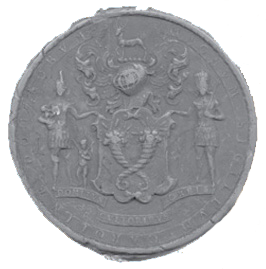The recent Boyd Symposium, held at Danson House in Bexleyheath near London, England, was a wonderful success. Danson House was built in the late 18th century by John Boyd, grandson of Jean Boyd whose 1686 letter from Charles Towne, with a map and botanical drawings, was published in 2006. Sponsored by the Bexley Heritage Trust, the Huguenot Society of Great Britain and Ireland and The Huguenot Society of South Carolina, the Boyd Symposium brought together seven scholars and professors who spoke on different aspects of the Boyd family and the merchant network with which they were connected.
The elegant Palladian house, completely restored a few years ago, proved to be the perfect setting for the symposium which included papers presented to a gathering of about 70 people, a wine-tasting offered by Chateau Boyd-Cantenac of wines from the Boyd estate near Bordeaux, France, and a candlelight dinner in the library with the magnificent built-in organ as a backdrop.
The setting for the symposium itself was the Dining Room with the restored cycle of allegorical wall paintings in gilded frames painted by Charles Pavillon in 1766 for Danson House as backdrops and the rolling terraces of the property visible through the windows. The talks were moderated by Professor John Miller of the University of London who noted the diversity of interests and subjects of the presenters. Dee Ressinger, independent scholar and Board member of the Huguenot Society of SouthCarolina, began the 1st Session with a discussion of the Boyds and their relatives and associates in 17th century Bordeaux. She was followed by Cheves Leland, independent scholar and Researcher/Archivist for the Huguenot Society of SouthCarolina, who presented a paper with Susan Bates (in absentia) on “The Most Beautiful Country of Carolina” as seen through 17th century letters. Bertrand Van Ruymbeke, professor at the University of Paris VIII, then presented his paper on “The Boyd letters and the politics of naturalization in 1690 South Carolina.” Each paper was followed by lively discussion and the session itself was followed by a buffet lunch in the Breakfast Room.
Following lunch Vivien Costello from the Huguenot Society of Great Britain and Ireland, presented a paper on the Irish Ramifications of the Boyd family, followed by Professor Louis Cullen, Professor Emeritus of Trinity College, Dublin, who spoke on the Boyds of Bordeaux in the 18thcentury. The 3rd Session began with a talk by Professor David Hancokc, University of Michigan, Ann Arbor, on Augustus Boyd. Daniel McGill, Ballycastle Historical Research Group, Ireland, then introduced the Boyd of Ballycastle archive which he and his wife Jayne McGill have catalogued and part of which was on display in Danson House. The BallycastleArchive includes miniatures of both John and Augustus Boyd, so “faces were put to names,” as the Boyd family returned to Danson House for a short visit.
After a guided tour of the house, with comments offered by the master archaeologist and restorer of the property, there was a wine tasting of wines from Chateau Boyd-Cantenac near Bordeaux, vineyards begun by an 18th century Boyd. Each speaker was presented with a bottle of Jacques Boyd Margaux. The symposium ended after a festive candlelight dinner in the library of Danson House.
After almost five years of research on the Boyd family, it was wonderful to see everything come together in such a dramatic way. An apt description offered by one of the presenters was that the symposium was similar to the poem “Six Blind Men and an Elephant” in that each presenter had been working on various aspects of the same family, but from different angles which all came together and formed a more complete picture of the family and its milieu than would have happened had everyone continued working separately. The Boyd Symposium was a fitting culmination for the work of all the presenters, although everyone present realized that there is yet more to discover, not only about the Boyd family, but about other Huguenot families. The Internet makes it so much easier and quicker for scholars to confer and share ideas and information. The papers upon which the talks presented at the Symposium were based will be published. Details will be provided as soon as they are available.
As a postscript: In addition to the Boyd Symposium, Dee Ressinger, Cheves Leland and Vivien Costello also presented papers to the Huguenot Society of Great Britain and Ireland at its Annual Meeting, held in London in the Dutch Church near Threadneedle Street. The papers were well-received and will published by the Society. Although time did not permit much sight-seeing, there was time for some research at The Royal Society, The British Archives and the National Archives. Look for more information about that in footnotes to our up-coming book on French Santee.

Leave a Reply